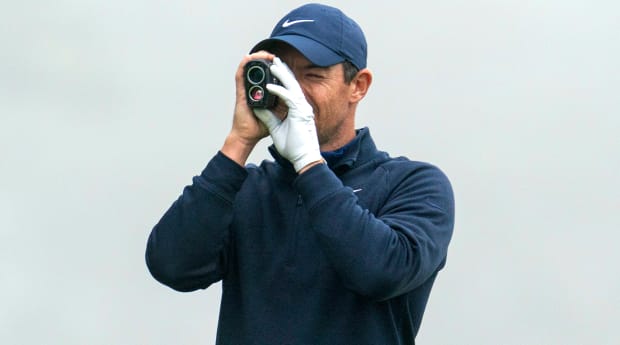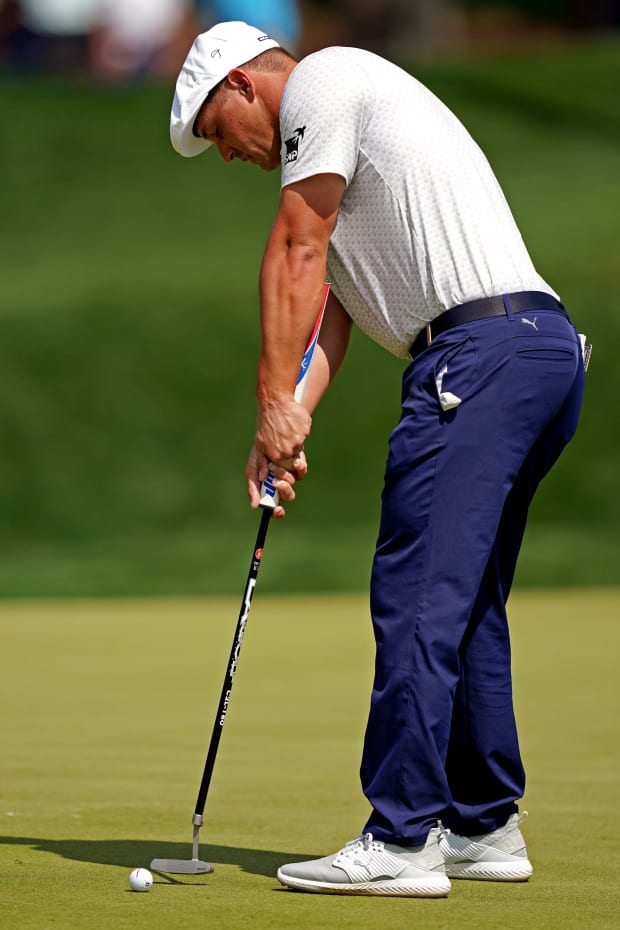Distance-measuring devices will be allowed this week at PGA Championship, but a ban on green-reading books would be better.
Americans are uncommonly inventive – and there’s nothing at all wrong with that – but golf, at times, is victimized by innovation just as much as it has benefitted from it. Easier is not necessarily better, faster for us isn’t always faster for them and the afflicted among us shouldn’t be penalized every time they find a way that works that might look a little funny.
Topic A is distance-measuring devices, or DMDs, aka rangefinders. The PGA of America, in one of its most head-scratching moves ever, is allowing DMDs this week at the PGA Championship on the Ocean Course at Kiawah Island, S.C.
“We’re always interested in methods that may help improve the flow of play during our championships,” Jim Richerson, the PGA’s president, said in a news release when the decision was announced in February. The PGA also will allow DMDs in the Women’s PGA and Senior PGA.

“The use of distance-measuring devices is already common within the game and is now a part of the Rules of Golf,” Richerson said. “Players and caddies have long used them during practice rounds to gather relevant yardages.”
Yes, it’s common among amateurs and even PGA professionals who don’t have yardage books or professional caddies in their tournaments. But the touring professionals – and their caddies – are steadfast in believing that DMDs won’t improve pace of play. In fact, the use of rangefinders during competition probably would slow things down.
Caddies on the PGA Tour and in major championships already get detailed yardage books, and the exact distance to the flagstick is not the only yardage they are calculating. Players want to know the distance to the front and back of each green and yardage to carry certain greenside bunkers. You can’t shoot those numbers accurately with rangefinders.
“I have a hard time seeing it speed things up, unless you get it way offline or you’re out of contention,” Jordan Spieth said.
The PGA Tour doesn’t want anything to do with DMDs in competition, having conducted a test over four tournaments on the Korn Ferry Tour in 2017. The USGA, which allows rangefinders only in amateur events, is taking its cue from the Tour.
“We would change in a Minnesota minute if the tours get comfortable with it,” Mike Davis, who is retiring this year as the USGA's executive director, told Morning Read. “My understanding is part of it is caddies aren’t crazy about it. I don’t think it’s necessarily the respective commissioners saying we don’t want them. I think it’s some of the players that don’t want it.”
If the PGA of America really were interested in speeding up play, it would decide not to allow green-reading books, which provide a detailed map of each green, showing direction and percentage of steepness of slopes. If you watch players who use them, they take an inordinate amount of time on the greens.
Augusta National Golf Club doesn’t allow the use of those books in the Masters, and the PGA Tour would do well to follow that lead. Reading greens is and should be an art, and giving players a detailed map of each green is more of an artificial aid than rangefinders. It’s simply too much help.
And now, there’s talk that arm-lock putting is more assistance than the law should allow. When anchored putting strokes were legislated out of the game in 2016, a number of players turned to the arm-lock method, popularized by Matt Kuchar. Webb Simpson and Keegan Bradley saved their careers arm-locking, and Bryson DeChambeau and Will Zalatoris simply think it’s a better way to putt.

Billy Horschel piped up and said he thought arm-lock was better than it should be.
“I’m bringing up something different here, and I’m sort going out on a limb, but I don’t think this arm-lock putting should be allowed, either,” he said at the RBC Heritage. “I’ll give the belly putter back and take away the arm-lock.
“Guys are doing it too good.”
All right, Billy, go get you one and see if it works “too good” for you. The bet here is that if Horschel performed better with the arm-lock method, he would keep his mouth shut and start living up to his potential.
Kevin Kisner, who by reputation, is one of the Tour’s best putters, had a dalliance with the arm-lock putter. It wasn’t an affair or even a fling. The experiment lasted less than two weeks. Even Kuchar is searching. Lately, he has been using sort of a reverse arm-lock by pressing the putter grip against his right arm instead of his left. Nothing, apparently, lasts forever.
However, one arm-lock putter in particular needs a closer look by rules officials, and it belongs to DeChambeau. The rules state that a putter must diverge from vertical by at least 10 degrees, which means that the lie angle is required to be 80 degrees or less. The rule applied mostly to long putters anchored to the chest, to prevent a perfect pendulum stroke. But to the educated naked eye, DeChambeau’s putter certainly doesn’t appear to meet the requirements of the rules.
Maybe a conscientious rules official will put DeChambeau’s putter on a loft-and-lie machine. Just to check.
More From Morning Read:
- Kiawah Island’s Ocean Course: By the Numbers
- Only Thing Super About Golf on TV: The Superlatives
- Kyoung-Hoon Lee Earns PGA Berth the Hard Way
Mike Purkey is a writer for MorningRead.com, a multimedia network that connects and informs golf enthusiasts on all aspects of the game, including news, travel, equipment, apparel and fitness.
Distance-measuring devices will be allowed this week at PGA Championship, but a ban on green-reading books would be better.
Americans are uncommonly inventive – and there’s nothing at all wrong with that – but golf, at times, is victimized by innovation just as much as it has benefitted from it. Easier is not necessarily better, faster for us isn’t always faster for them and the afflicted among us shouldn’t be penalized every time they find a way that works that might look a little funny.
Topic A is distance-measuring devices, or DMDs, aka rangefinders. The PGA of America, in one of its most head-scratching moves ever, is allowing DMDs this week at the PGA Championship on the Ocean Course at Kiawah Island, S.C.
“We’re always interested in methods that may help improve the flow of play during our championships,” Jim Richerson, the PGA’s president, said in a news release when the decision was announced in February. The PGA also will allow DMDs in the Women’s PGA and Senior PGA.

“The use of distance-measuring devices is already common within the game and is now a part of the Rules of Golf,” Richerson said. “Players and caddies have long used them during practice rounds to gather relevant yardages.”
Yes, it’s common among amateurs and even PGA professionals who don’t have yardage books or professional caddies in their tournaments. But the touring professionals – and their caddies – are steadfast in believing that DMDs won’t improve pace of play. In fact, the use of rangefinders during competition probably would slow things down.
Caddies on the PGA Tour and in major championships already get detailed yardage books, and the exact distance to the flagstick is not the only yardage they are calculating. Players want to know the distance to the front and back of each green and yardage to carry certain greenside bunkers. You can’t shoot those numbers accurately with rangefinders.
“I have a hard time seeing it speed things up, unless you get it way offline or you’re out of contention,” Jordan Spieth said.
The PGA Tour doesn’t want anything to do with DMDs in competition, having conducted a test over four tournaments on the Korn Ferry Tour in 2017. The USGA, which allows rangefinders only in amateur events, is taking its cue from the Tour.
“We would change in a Minnesota minute if the tours get comfortable with it,” Mike Davis, who is retiring this year as the USGA's executive director, told Morning Read. “My understanding is part of it is caddies aren’t crazy about it. I don’t think it’s necessarily the respective commissioners saying we don’t want them. I think it’s some of the players that don’t want it.”
If the PGA of America really were interested in speeding up play, it would decide not to allow green-reading books, which provide a detailed map of each green, showing direction and percentage of steepness of slopes. If you watch players who use them, they take an inordinate amount of time on the greens.
Augusta National Golf Club doesn’t allow the use of those books in the Masters, and the PGA Tour would do well to follow that lead. Reading greens is and should be an art, and giving players a detailed map of each green is more of an artificial aid than rangefinders. It’s simply too much help.
And now, there’s talk that arm-lock putting is more assistance than the law should allow. When anchored putting strokes were legislated out of the game in 2016, a number of players turned to the arm-lock method, popularized by Matt Kuchar. Webb Simpson and Keegan Bradley saved their careers arm-locking, and Bryson DeChambeau and Will Zalatoris simply think it’s a better way to putt.

Billy Horschel piped up and said he thought arm-lock was better than it should be.
“I’m bringing up something different here, and I’m sort going out on a limb, but I don’t think this arm-lock putting should be allowed, either,” he said at the RBC Heritage. “I’ll give the belly putter back and take away the arm-lock.
“Guys are doing it too good.”
All right, Billy, go get you one and see if it works “too good” for you. The bet here is that if Horschel performed better with the arm-lock method, he would keep his mouth shut and start living up to his potential.
Kevin Kisner, who by reputation, is one of the Tour’s best putters, had a dalliance with the arm-lock putter. It wasn’t an affair or even a fling. The experiment lasted less than two weeks. Even Kuchar is searching. Lately, he has been using sort of a reverse arm-lock by pressing the putter grip against his right arm instead of his left. Nothing, apparently, lasts forever.
However, one arm-lock putter in particular needs a closer look by rules officials, and it belongs to DeChambeau. The rules state that a putter must diverge from vertical by at least 10 degrees, which means that the lie angle is required to be 80 degrees or less. The rule applied mostly to long putters anchored to the chest, to prevent a perfect pendulum stroke. But to the educated naked eye, DeChambeau’s putter certainly doesn’t appear to meet the requirements of the rules.
Maybe a conscientious rules official will put DeChambeau’s putter on a loft-and-lie machine. Just to check.
More From Morning Read:
- Kiawah Island’s Ocean Course: By the Numbers
- Only Thing Super About Golf on TV: The Superlatives
- Kyoung-Hoon Lee Earns PGA Berth the Hard Way
Mike Purkey is a writer for MorningRead.com, a multimedia network that connects and informs golf enthusiasts on all aspects of the game, including news, travel, equipment, apparel and fitness.


0 Comments